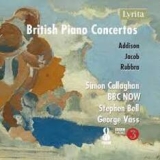Gordon Jacob (1895-1984) komponierte rund vierhundert Werke, darunter zwei Symphonien, mehrere Konzerte, Kammermusik, Chorwerke, Lieder und Film- sowie Fernsehmusik. Sein Zweites Klavierkonzert von 1957 beginnt mit einem verspielten rhythmischen Satz, auf den ein lyrischer, poetischer, teils auch wiederum sehr munterer Variationensatz folgt. Ein unbeschwert virtuoser Satz beendet das Konzert, dessen Ideenfülle beeindruckt und es zu einem sehr attraktiven, hörenswerten Werk macht.
John Addison (1920-98) schrieb Variations for Piano and Orchestra im Jahre 1948. Es ist ein sehr expressives, oft düster gefärbtes Werk, das obwohl mitunter sehr virtuos im Klavierpart, vor allem durch den Orchestersatz auffällt.
Edmund Rubbra (1901-86) hat mit seinem Klavierkonzert von 1930 ein äußerst originelles Stück komponiert, dessen Farben- und Ideenreichtum es wirklich charakteristisch und attraktiv machen.
Gute und engagierte Interpretationen machen aus diesen drei Ersteinspielungen ein hörenswertes Programm.
Gordon Jacob (1895-1984) composed some four hundred works, including two symphonies, several concertos, chamber music, choral works, songs, and film and television music. His Second Piano Concerto of 1957 begins with a playful rhythmic movement, followed by a lyrical, poetic, and in some cases very lively variation movement. A light-hearted virtuoso movement ends the concerto, whose wealth of ideas is impressive and makes it a very attractive work worth hearing.
John Addison (1920-98) wrote Variations for Piano and Orchestra in 1948, and it is a very expressive, often somberly colored work that, although sometimes very virtuosic in the piano part, is most notable for its orchestral writing.
Edmund Rubbra (1901-86) composed a highly original piece in his 1930 Piano Concerto, whose richness of color and ideas make it truly distinctive and attractive.
Good and committed interpretations make these three premiere recordings a program worth listening to.






















